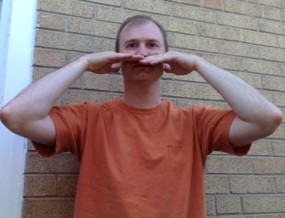Orality vs. Nasality
 I think that most of us have heard of nasality before. Did you know that it’s opposite is something called orality? It makes sense, I suppose. As we have discussed in other blog posts, this nasal quality comes from dropping the soft palate, while the oral quality comes from lifting it. This can be quite a subtle thing, of course, and I’ve recently written about that, too.
I think that most of us have heard of nasality before. Did you know that it’s opposite is something called orality? It makes sense, I suppose. As we have discussed in other blog posts, this nasal quality comes from dropping the soft palate, while the oral quality comes from lifting it. This can be quite a subtle thing, of course, and I’ve recently written about that, too.
Feeling orality is something that we may not even be aware of, either. I have an old little exercise that I do early on with students to explore the sensation of feeling the vibration of the voice in the nasal passages, and then contrasting that sensation with a very lifted palate for extreme vibration in the oral cavity exclusively. I don’t really have a name for the exercise, so orality vs. nasality will have to do!
Step One: Hyper-nasal
This seems to be very easy for my students to do, so I trust that it will be easy for you. Talk with an extremely nasal voice. If necessary, channel the character Janice, played by [Maggie Wheeler: ](http://www.imdb.com/rg/tw_oshare/rt_ipad/name/nm0923909 #IMDb), from the tv show Friends. You can ditch the New York accent, and just be you with a lot of nasality.
Step Two: Divide your Head in Half!
This is where it gets a little weird. You take your hands, and keeping your palms facing down, parallel to the floor, place your index fingers under your nose and your thumbs around the side of your head, just behind your ears. You’re trying to make an acoustic block between the top half of your head and the bottom half, to hear the sound coming out your nose and out your mouth very clearly. Keep talking with your nasal voice, and you should feel and hear the sound of that nasality very much above your hands.
Step Three: Lift your soft palate
Keeping your hands where they are, lift your soft palate aggressively to make your voice come out of your mouth entirely. This can be similar to the sound of “talking with a cold”; if you do it completely, you will become what is called denasal which will change your nasal stop plosion consonants, /m, n, ŋ/ into oral stop plosives, /b, d, g/. So hum a fine song comes out something like hub a fide sog. With your hands still splitting your head in half, you should really hear and feel the sound of your voice below your hands.
Step Four: Flipping Back and Forth
So we’ve been hyper nasal and hypo nasal (aka oral). Regular speech, on the other hand, combines both basil and speech. This is something that you’re used to: we generally don’t notice the flip back and forth. Keeping your hands in the same position, talk normally and see if you can feel your voice flipping between
- sound coming out your nose on nasal consonants (and possibly on vowels preceding those consonants), and
- sound coming out of your mouth (pretty much every thing else!).
It helps to speak slowly, so that you can feel that shift between top of head and bottom of head. Of course, once you can feel like, you can stop with the hands thing and just feel the flip.
Could you also call orality or de-nasalized speech hypo-nasal? Or is hypo-nasality something else?
I think of the term “hypo-nasal” as being more “medical”. Of course, denasal and hypo-nasal are about “not being nasal”, while “orality” is about being oral, with resonance focused in the mouth rather than the nose. I also think it is a question of degree. Orality is part of everyday speech, as is nasality. Hyper- and hypo-, to me are about nasality in the wrong place. I want to focus on the sensation of vibration in the RIGHT place. Does that make sense?